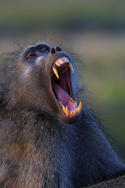General Description

Baboons have a dog-like shaped head to which the species name cyno-cephalus refers literally meaning “dog-head”. Baboons have forward-facing eyes that allow them to see with binocular vision.
Binocular vision is vital in animals that need to gauge depth and distance such as baboons do when jumping from branch to branch in trees. Baboons spend a fair deal of time sitting while they are feeding and they have subsequently developed built-in cushions on their buttocks called ischial callosities.
In females these are separate but in males, they fuse to form a band below his anus. Chacma baboons have a characteristic kink in their tails. Baboons sleep above the ground at night.
As with humans, colour vision works better during the day than at night and because they are rendered vulnerable at this time, they sleep in tall trees along rivers or up against cliffs.
Baboon troops may not necessarily return to the same roosting site every evening but they do have favourite sites that they frequent and may even defend against other troops if roosting places are in short supply.
At night they will perform a racket if disturbed even urinating and defecating upon the source of the disturbance below. Favourite sleeping sites smell strongly and are stained by baboon excrement over time.
By Megan Emmett